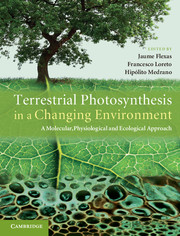 Terrestrial Photosynthesis in a Changing Environment
Terrestrial Photosynthesis in a Changing Environment Book contents
- Frontmatter
- Contents
- List of contributors
- Preface
- Acknowledgements
- List of abbreviations
- 1 Terrestrial photosynthesis in a changing environment
- Part I Photosynthesis
- Part II Measuring photosynthesis
- Part III Photosynthetic response to single environmental factors
- Part IV Photosynthesis in time
- Part V Photosynthesis in space
- 26 Whole-plant photosynthesis: potentials, limitations and physiological and structural controls
- 27 Ecophysiology of photosynthesis in the tropics
- 28 Ecophysiology of photosynthesis in desert ecosystems
- 29 Ecophysiology of photosynthesis in semi-arid environments
- 30 Ecophysiology of photosynthesis in temperate forests
- 31 Ecophysiology of photosynthesis in boreal, arctic and alpine ecosystems
- 32 Crop photosynthesis
- Part VI Photosynthesis in a global context
- References
- Index
31 - Ecophysiology of photosynthesis in boreal, arctic and alpine ecosystems
Published online by Cambridge University Press: 05 March 2013
- Frontmatter
- Contents
- List of contributors
- Preface
- Acknowledgements
- List of abbreviations
- 1 Terrestrial photosynthesis in a changing environment
- Part I Photosynthesis
- Part II Measuring photosynthesis
- Part III Photosynthetic response to single environmental factors
- Part IV Photosynthesis in time
- Part V Photosynthesis in space
- 26 Whole-plant photosynthesis: potentials, limitations and physiological and structural controls
- 27 Ecophysiology of photosynthesis in the tropics
- 28 Ecophysiology of photosynthesis in desert ecosystems
- 29 Ecophysiology of photosynthesis in semi-arid environments
- 30 Ecophysiology of photosynthesis in temperate forests
- 31 Ecophysiology of photosynthesis in boreal, arctic and alpine ecosystems
- 32 Crop photosynthesis
- Part VI Photosynthesis in a global context
- References
- Index
Summary
Photosynthesis in the Cold and the Snow?
In this chapter we discuss photosynthesis and productivity of plants in arctic, alpine and boreal environments. These environments are characterised by cold climate and dominated by plants that thrive in these harsh and often not very productive environments. We concentrate on alpine plants from ‘non-tropical’ mountains and on higher plants, reflecting mostly our own experience and the larger body of literature, which is available for the non-tropical mountains, as well as the need to focus on general aspects. It is noteworthy to mention that there is a growing number of fascinating studies on tropical and subtropical mountain ecosystems, such as the Andes or the Tibetean plateau. However, here we aim to focus on the general features of alpine environments. We will not be able to address the vast diversity of microclimatic and local differences occuring thoughout the number of temperate and tropical alpine ecosystems. We will also omit the effects of UV-B radiation on plants, as this important abiotic factor is not exclusive to mountain environments.
Climatic conditions of arctic, boreal and alpine environments challenge photosynthesis of plants in several ways. During the winter, plants are either covered by snow, which creates a relatively sheltered environment, or they are exposed to cold temperatures as well as ice and snow particles blown by wind. These particles might cause mechanical damage by abrasion on leave surfaces of evergreen plants. As Thomas Elliot wrote: ‘April is the cruelest month. Winter kept us warm, covered by the forgetfulness of snow’. Spring does not necessarily mean less-harsh conditions and smaller challenges for photosynthesis. Temperatures are changing rapidly from sub-zero to high temperatures, and irradiance levels can be extremely high, imposing stress and causing photoinhibitory damage to photosynthetic tisssue. At the same time, plants must prepare themselves rapidly for life during a short summer, during which they need to acquire all the carbon required for reproduction as well as growth and respiration through the next winter.
- Type
- Chapter
- Information
- Terrestrial Photosynthesis in a Changing EnvironmentA Molecular, Physiological, and Ecological Approach, pp. 488 - 505Publisher: Cambridge University PressPrint publication year: 2012
- 1
- Cited by


